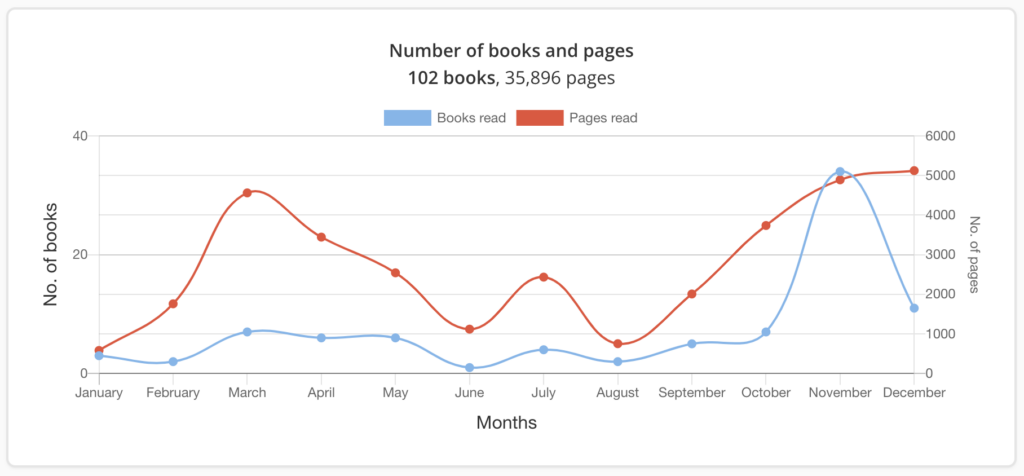Sitting down on the first day of a new year to share something with you feels a bit… different. Over the years, I’ve been hit or miss with my blog posts and have never really achieved a consistent posting schedule.
That changes in 2023.
Along with adopting a regular posting schedule, I’m setting my goal for my reading this year. I’ve done a yearly reading challenge for the past three years and read over 100 books annually in 2021 and 2022.
For 2023, I’m upping the book count to 150.
Why? Because I looked back at my reading numbers and saw “gaps” in my reading time throughout the year. Here’s a look at my reading stats for 2022 from Storygraph:

As you can see, my reading progress suffered in January, February, June, and August. November is abnormally high due to a LARGE number of short audiobooks. I worked really hard to get my numbers for the year up. Yes, I achieved my goal, but I wasn’t smart about it.
I’ve got a better plan in place this year, not only to read more books but learn more from what I read. And that plans start with setting a goal.
Setting a Reading Goal
Setting a goal for the number of books you want to read in a certain time period can be a powerful way to help you read more. Here are some tips for making this goal actionable:
- Be specific and measurable. Rather than setting a vague goal like “I want to read more,” set a specific target like “I want to read one book per month.” This way, you’ll have a clear benchmark to measure your progress.
- Make the goal achievable but challenging. Choose a goal that is challenging enough to motivate you but not so difficult that it becomes discouraging. If you’re new to reading, for example, starting with a goal of one book per month might be a good place to start. As you get more comfortable reading, you can gradually increase your goal.
- Set a deadline. Giving yourself a deadline can help you stay on track and ensure that you don’t put off reading. You might set a goal to read one book per month for a year, for example, or to read a certain number of books by a specific date.
- Write down your goal and track your progress. Put your goal in writing and post it somewhere visible as a reminder. You could also use a reading tracker or app to keep track of your progress. Seeing your progress in black and white can be a powerful motivator.
- Celebrate your achievements. When you reach your reading goal, take a moment to celebrate your accomplishment. This could be something small, like treating yourself to a new book or your favorite dessert, or something bigger, like taking a trip or going out for a special dinner. Whatever you choose, make sure to take some time to enjoy your success and give yourself credit for all the hard work you put in.

Of course, I’ll be documenting my progress and learning from what I read right here on this site. You can find my GoodReads profile here if you want to see the books as I’m reading, or check right here on the blog for updates with the tag 2023 reads.
Have you set your own reading goal for 2023? Keep watching here as I’ll share more tips in January to help you read more.
MP
Thanks for reading. Get access to exclusive content and expert insights on technology, teaching, and leadership by subscribing to my newsletter. Stay up-to-date on the latest trends and join our community of professionals and educators worldwide.
